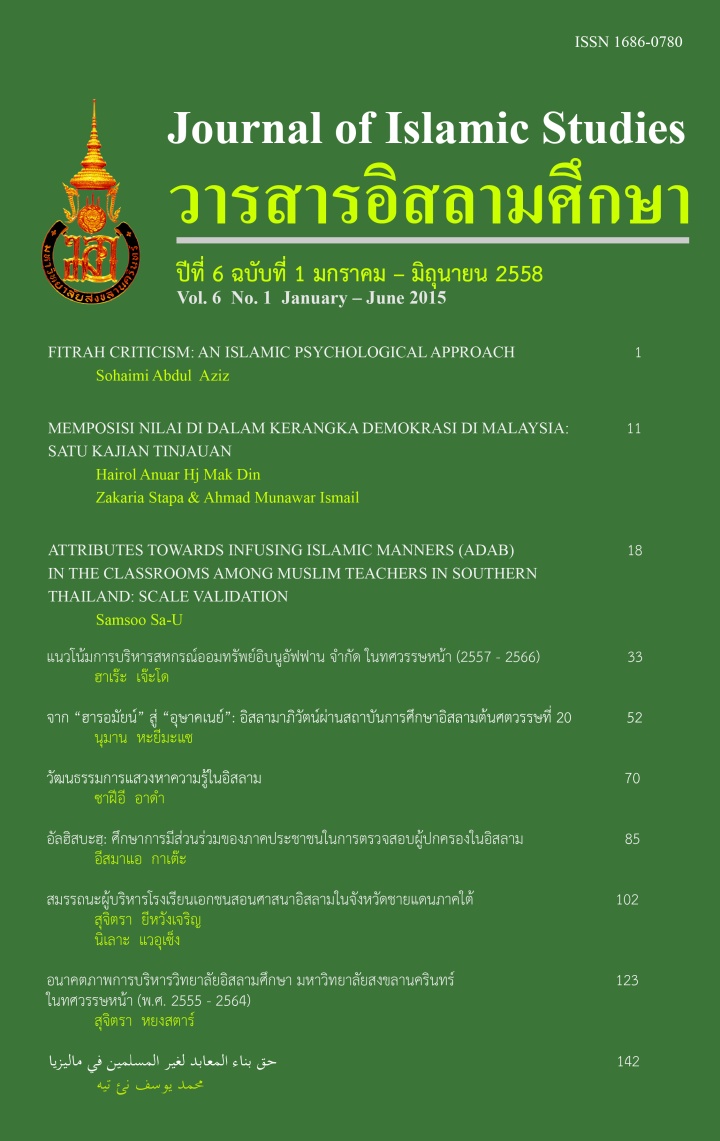จาก “ฮารอมัยน์” สู่ “อุษาคเนย์” : อิสลามาภิวัตน์ผ่านสถาบันการศึกษาอิสลาม ต้นศตวรรษที่ 20
บทคัดย่อ
ฮารอมัยน์ (Haramayn) เป็นดินแดนที่มีความสำคัญในฐานะเป็นศูนย์กลางจิตวิญญาณ ศูนย์กลางการศึกษาศาสนา และศูนย์กลางการประกอบศาสนกิจฮัจญ์ ในเดือนซูลฮิจญะฮฺตามปฏิทินอิสลาม สำหรับชาวอุษาคเนย์แล้ว ในด้านการศึกษาวิชาการศาสนา ฮารอมัยน์ถือเป็นศูนย์กลางที่สำคัญในกระบวนการถ่ายทอดความรู้ผ่านผู้รู้ทั้งที่มาจากอุษาคเนย์หรือจากภูมิภาคอื่นๆ มาตั้งแต่ศตวรรษที่ 17 จนถึงต้นศตวรรษ 20 สถาบันการศึกษาในฮารอมัยน์มีความสำคัญอย่างยิ่งในการหล่อหลอมความเป็นมุสลิมที่สมบูรณ์แบบทั้งทางโลกและทางธรรม กระบวนการเรียนการสอนผ่านสถาบันการศึกษาทั้งที่ศึกษาผ่านระบบโรงเรียน (Madrasah) และระบบดั้งเดิมที่เน้นการล้อมวงโดยมีผู้รู้เป็นแกนกลางในการถ่ายทอดความรู้ (Halaqah) ได้ส่งผ่านมายังชาวอุษาคเนย์ให้ได้นำประสบการณ์ที่สั่งสมมากลับมาถ่ายทอดในชุมชนของตนและถือเป็นรากฐานสำคัญของพัฒนาการด้านอิสลามาภิวัตน์ในอุษาคเนย์ตลอดศตวรรษที่ 20
เอกสารอ้างอิง
Azyumardi Azra. 1994. Jaringan Ulama Timur Tengah dan Kepulaun Nusantara Abad XVII dan XVIII. Jakarta: Mizan.
Azyumardi Azra. 2000. Renaisans Islam Asia Tenggara: Sejarah Wacana dan Kekuasaan. Bandung: PT Remaja Rosdakarya.
Azyumardi Azra. 2005. Dari Harvard Hingga Makkah. Jakarta: Penerbit Republika.
C.Snouck Hurgronje. 1931. Mekka in the Latter Part of the 19th Century. Leiden: E.J.Brill.
Hasan Madmarn. 2001. The Pondok and Madrasah in Patani. Bangi: Universiti Kebangsaan Malaysia Press.
M.F Laffan. 2003. Islamic Nationhood and Colonial Indonesia: The Umma Below the Wind. London: RouledgeCurzon.
Martin van Bruinessen. 1995. Kitab Kuning: Pesantren dan Tarekat, Tradisi-tradisi Islam di Indonesia. Bandung: Mizan.
Robert R. Bianchi. 2004. Guests of God: Pilgrimage and Politics in the Islamic World. Oxford: Oxford University Press.
S.I Gellens. 1990. “The Search for Knowledge in Medieval Muslim Societies: A Comparative Approach”, in Muslim Travelers: Pilgrimage, Migration and the Religion Imagination, D.F Eickelmann & J. Piscatori (eds.) Berkeley: University of California Press.
Victor Turner. 1969. The Ritual Process: Structure and Anti-Structure. London: Rouledge & Kegan Paul.
Wan Mohd. Shaghir Abdullah. 1992. al-‘Allamah Syeikh Ahmad al-Fathani : Ahli Fikir Islam dan Guru kepada Hampir Semua Ulama dan Tokoh Asia Tenggara Abad ke 19-20. Kuala Lumpur: Khazanah Fathaniyah.
Zainal Efendi Hasibuan. 2007. “Profil Rasulullah sebagai Pendidik Ideal: Telaah Pola Pendidikan Islam Era Rasulullah Fase Mekka dan Madinah”, in Sejarah Pendidikan Islam: Menelusuri Jejak Sejarah Pendidikan Era Rasulullah Sampai Indonesia, Samsul Nizar, H. (ed.). Jakarta : Kencana Prenada Media Group.
หอจดหมายเหตุแห่งชาติ แฟ้มกระทรวงการต่างประเทศ หมายเลข 43.2/82. เรื่อง “งบเงินค่าใช้จ่ายในการดูแลนักเรียนไทยในซาอุดีอาระเบีย ปี พ.ศ. 2505- 2509”
หอจดหมายเหตุแห่งชาติ แฟ้มกระทรวงมหาดไทย หมายเลข 3.1.4.19/52. เรื่อง “การช่วยเหลือไทยอิสลามไปประกอบศาสนกิจ ณ เมืองมักกะ วันที่ 21 ธันวาคม 2498 -11 สิงหาคม 2503”
ดาวน์โหลด
เผยแพร่แล้ว
รูปแบบการอ้างอิง
ฉบับ
ประเภทบทความ
สัญญาอนุญาต
บทความทุกเรื่อง ที่ได้รับการตีพิมพ์ในวารสารอิสลามศึกษาเป็นแนวคิดของผู้เขียน มิใช่เป็นความคิดเห็นคณะผู้จัดทำและมิใช่ความรับผิดชอบของคณะวิทยาการอิสลาม กองบรรณาธิการไม่สงวนสิทธิ์การคัดลอก แต่ให้มีการอ้างอิงแสดงที่มา




